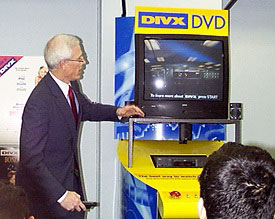
Over the past 10-15 years, there have been a series of developments in how games are sold. In that time frame we’ve seen the mass acceptance of the subscription model, it’s apex, and its decline. We’ve seen free-to-play and Kickstarter. What I would like to talk about today, though, is early access.
Redefining the product life cycle
Even with all of these developments, and how many games now continue to receive updates after they are released, the prevailing mode of thought is to treat games as a boxed product. Most of them encapsulate a story and are therefore finite things that have an ending. So, inherently the buyer thinks of it as a completed product. However, this often isn’t the case. Issues in the game may need to be addressed, additional content could be created to draw in more consumers, or other factors could be cause for an update.
Other types of software don’t usually have this same problem. It’s understood that they will constantly be subject to more work as the developer tries to improve the product. They’ll never be finished. That’s because that software doesn’t represent anything remotely approaching a closed experience. It is a tool, and a service that you have purchased a license for. The tool is subject to update just as the license may be subject to renewal for more money.
For example, if you purchase a game, you likely wouldn’t naturally expect continued updates from the developer. However, if you bought anti-virus software, and the virus definitions never got updated, you should be quite upset with that.
With respect to games, though, the “boxed product” mentality does not hold well anymore. Digital distribution, online features, more devices on which to play than ever before, it is nearly impossible for a developer to “finish” a game entirely, and let it sit there to be sold. If nothing else, for a game to continue to sell, it would need additional attention to ensure it still functions on new devices as time goes on. Not even console exclusive games are immune to that effect, as firmware updates CAN and WILL break something sooner or later.
So, the idea of “ending” development, or perhaps developer support is a better term, entirely for a game is not viable for most titles. We must remove ourselves from that strict definition. No matter how natural it may feel, the more you consider the complexities involved the more you realize it simply does not function that way anymore.
Redefining the “Sale”
One reason that it remains so natural to think of games as complete “boxed products” is as I mentioned above, they most often represent a closed experience, telling a story with a beginning, middle, and an end. It would be ridiculous to pay a license for a movie, or a book. They are consumable and static, so to have it is to have it.

Remember Divx DVD? “We’re going to let you rent a movie, then if you don’t watch it in a day, you can pay again to watch it later. Then you could pay again to actually own it. But, your player has to call us to make sure you have the right to watch it.” Licensing home video… It died a swift death.

And movies are static once ‘finished’? Well, at least they probably should be.
Games, being software, don’t inherently fall under that category though. Initially, with non networked systems, cartridges and CDs, it may have, but this is less and less so as time goes on.
With the end point of development blown open, though, what about the start point? It’s not uncommon for games to ship with issues, known or unknown to the developer, that require continued support. So, what is so special about the “release” date? If development support does not end, when does the initial development end and the title considered ready for the public?
Going back to other forms of software, there are other many projects that don’t wait for things to be released to the public. Betas, previews, open source, the fact that you can choose between “latest build” and “latest stable build”, there are many ways that as a customer you can have access to something before it is “ready for public consumption”.
Here we finally get to the idea of “early access”. Since the only distinction for a game being sold is the developer saying “it’s ready now”, and the developers are beholden to support the game after release, what need is there to so rigidly subscribe to the “release date” strategy?
The answer to that question is actually advertising, but let’s ignore that for now as it usually applies to large titles, and early access is usually for smaller titles.
So, early access came about. Players pay to play the game before it is “done”. Often this will be for a lower price than its usual release price, or it could come with in game rewards. In return, the developer gets early feedback from players, larger test groups to put strain on servers if the game uses them to make sure the game scales well, and some infusion of capital from these early sales. Sounds good all around right? In a number of ways it is.
What’s good for the player
Game players are not always known for their patience.

If I freeze myself, then in three weeks, when Nintendo Wii comes out, you guys can unfreeze me. The wait will seem instantaneous to me.
With early access, we can play a game that we are interested in well before it would have been released otherwise, and we can get it possibly at a significant discount. We are showing support for projects that we like. Perhaps most significantly, we can give feedback about the title while it is still in a formative stage. For example, the game Skara had its targeting system re-worked entirely due to feedback from early access players.
What’s good for the developer
Game development is a difficult and unforgiving business to be in. It can be subject to all of the difficulties of the software industry with changing technology, sales models, business practices, and everyone competing with you constantly looking to disrupt every practice you rely on. It can also be subject to many of the difficulties of the entertainment industry with fads, changing tastes, the need to get an audience, and then meet its expectations while still doing things to grow that audience. Early access can give developers wiggle room on several of those points.
Normally the development cycle requires that creativity be reigned in, and kept to a budget of both time and money. This usually means that they have to not only be very disciplined in their execution, they may have to give up on features they really wanted, but can’t be fit in the scope. There is also very little margin for error, because if they run out of money to fund the development, then everything is done. On top of that, if there are assumptions made in the design that aren’t in line with what the market, or their target consumers actually want, then it’ll all be for nothing anyway.
If instead, the developer can let some players pay to play early, then they can get an infusion of money to help fund more development, and possibly bring some of those features back into scope. Feedback can also make sure that the feature set will appeal to potential consumers. Developers will often pay to have focus groups see a game as research, and while focus groups can be observed more closely, they are also a small handful of players with a short period of time with the game so they are shepherded through a semi scripted play experience. More players with more time means more feedback from a more natural play experience.
What’s bad for the player
Here’s where things get a bit sticky, though. Early access has a similar caveat as Kickstarter, but with less security. Just because something is available there does not mean it will be completed. Kickstarter has some protections in place, such as if the goal isn’t met, donations are returned. Early access, on the other hand, is simply a purchase of an unfinished product. Game development is a difficult business, and there can be myriad reasons for the project to never be in a state where it can be released. This risk must be understood, and in fact Steam’s FAQ for early access was updated to reflect this.

Before…

…and after
There is also a risk that a player may not understand the real difference between the different milestones, and therefore the proper state that the game could be in when it is purchased. It could be in a state where it is nearly ready for release, features are implemented, and it can be seen as a complete playable experience. It could be in a state where it is a viable product, but there are many features that the developer still wants to implement. It could be in a state where it is riddled with bugs. It could be in a state where it is missing features, is riddled with bugs, and could not be considered at all playable. And this is only considering options where the game was listed as early access by a scrupulous developer.
It is possible for a developer to simply slap something together, and label it as “early access” to make some money off of gullible consumers. Grand or intriguing promises can be made, a poor product can be hastily thrown together and put on the market to make some money. Then, the production can run into “insurmountable difficulties” and all development ceases, if they even give a reason. One would hope that Steam would work to police such actions, but that can never be assumed to be a safe bet. As a policy, Steam won’t issue refunds for purchase of an early access game, so it is absolutely a case of “buyer beware”.
All shady things aside, there is still a very real risk for the player. Since the game is in development still, it is a distinct possibility that the game that comes out is not the same game that was purchased. A critical feature could change, or many features could change, that fundamentally alter the player experience. For example, recently Rust changed its character creation system such that the player can no longer design their own appearance, and are locked to that appearance from then on. This had the immediate effect of exposing some latent racism in some of the players, but there is an additional consideration here. Games are often meant to be fantasy, and escapism. Some are power fantasies, and others can be disempowering fantasies. In any case, what you are expecting from the game is a certain type of experience. Having a forced and randomized character appearance can generate a certain kind of experience for a player, but that is not the experience that many players had spent money on. Many would have wanted to be able to project themselves into the game, and having their appearance suddenly dictated, where it hadn’t been originally, is certainly jarring. This is well within the developers rights to do this (unless they themselves put some really unusual content in their terms & conditions), but it will come across to players as a bait and switch, as they were promised one experience that was then taken and replaced with another.
What’s bad for the developer
Honestly, there’s not much bad for a developer in this deal. That’s part of why it’s become popular. There are only a few pitfalls. One is that if this is a major title, then early access would make managing an advertising campaign difficult, as player expectations would be getting formed before the product is ready for it. Also, it makes the release date difficult to manage, and therefore difficult to set any significant campaigns for it. Another pitfall is if you release very early, and players don’t appreciate that this isn’t considered playable or stable yet. This misperception could lead to a backlash.

THREE AND A HALF YEARS!!!
Other oddities
Now, I’d like to bring up the case that made me think of this topic in the first place: Kerbal Space Program. This is a game that has been available in beta/early access for more time than many games spend in development in the first place. I actually don’t think there’s anything inherently wrong with this. As I spoke about earlier, there is value in redefining when things are “released”, just as it has been forced to redefine when things are “complete”. I will say, however, that there’s an argument to be made with Kerbal that it should just be accepted that this is a released product. It’s a product that’s been on sale for years. Calling it anything else at this point just doesn’t feel right. It’s been so long that it may have already been purchased by a large number of the people interested in it. It’s been on sale! Stop calling it a Beta! It’s released already! You can still work on it after it’s released.
Sheesh, I guess it’s just a label, and while labels often conform to patterns and structures, in the end they are arbitrary. Apparently Squad (the developer) is going to take it out of early access soon. It will be interesting to see what this means for the play experience, or if it means the price will be going up, or if ANYTHING will change other than that arbitrary label.
Kynetyk is a veteran of the games industry. Behind the Line is written to help improve understanding of what goes on in the game development process and the business behind it. From “What’s taking this games so long to release”, to “why are there bugs”, to “Why is this free to play” or anything else, if there is a topic that you would like to see covered, please write in to kynetyk@enthusiacs.com








Behind the Line: Early Access
Over the past 10-15 years, there have been a series of developments in how games are sold. In that time frame we’ve seen the mass acceptance of the subscription model, it’s apex, and its decline. We’ve seen free-to-play and Kickstarter. What I would like to talk about today, though, is early access.
Redefining the product life cycle
Even with all of these developments, and how many games now continue to receive updates after they are released, the prevailing mode of thought is to treat games as a boxed product. Most of them encapsulate a story and are therefore finite things that have an ending. So, inherently the buyer thinks of it as a completed product. However, this often isn’t the case. Issues in the game may need to be addressed, additional content could be created to draw in more consumers, or other factors could be cause for an update.
Other types of software don’t usually have this same problem. It’s understood that they will constantly be subject to more work as the developer tries to improve the product. They’ll never be finished. That’s because that software doesn’t represent anything remotely approaching a closed experience. It is a tool, and a service that you have purchased a license for. The tool is subject to update just as the license may be subject to renewal for more money.
For example, if you purchase a game, you likely wouldn’t naturally expect continued updates from the developer. However, if you bought anti-virus software, and the virus definitions never got updated, you should be quite upset with that.
With respect to games, though, the “boxed product” mentality does not hold well anymore. Digital distribution, online features, more devices on which to play than ever before, it is nearly impossible for a developer to “finish” a game entirely, and let it sit there to be sold. If nothing else, for a game to continue to sell, it would need additional attention to ensure it still functions on new devices as time goes on. Not even console exclusive games are immune to that effect, as firmware updates CAN and WILL break something sooner or later.
So, the idea of “ending” development, or perhaps developer support is a better term, entirely for a game is not viable for most titles. We must remove ourselves from that strict definition. No matter how natural it may feel, the more you consider the complexities involved the more you realize it simply does not function that way anymore.
Redefining the “Sale”
One reason that it remains so natural to think of games as complete “boxed products” is as I mentioned above, they most often represent a closed experience, telling a story with a beginning, middle, and an end. It would be ridiculous to pay a license for a movie, or a book. They are consumable and static, so to have it is to have it.
Remember Divx DVD? “We’re going to let you rent a movie, then if you don’t watch it in a day, you can pay again to watch it later. Then you could pay again to actually own it. But, your player has to call us to make sure you have the right to watch it.” Licensing home video… It died a swift death.
And movies are static once ‘finished’? Well, at least they probably should be.
Games, being software, don’t inherently fall under that category though. Initially, with non networked systems, cartridges and CDs, it may have, but this is less and less so as time goes on.
With the end point of development blown open, though, what about the start point? It’s not uncommon for games to ship with issues, known or unknown to the developer, that require continued support. So, what is so special about the “release” date? If development support does not end, when does the initial development end and the title considered ready for the public?
Going back to other forms of software, there are other many projects that don’t wait for things to be released to the public. Betas, previews, open source, the fact that you can choose between “latest build” and “latest stable build”, there are many ways that as a customer you can have access to something before it is “ready for public consumption”.
Here we finally get to the idea of “early access”. Since the only distinction for a game being sold is the developer saying “it’s ready now”, and the developers are beholden to support the game after release, what need is there to so rigidly subscribe to the “release date” strategy?
The answer to that question is actually advertising, but let’s ignore that for now as it usually applies to large titles, and early access is usually for smaller titles.
So, early access came about. Players pay to play the game before it is “done”. Often this will be for a lower price than its usual release price, or it could come with in game rewards. In return, the developer gets early feedback from players, larger test groups to put strain on servers if the game uses them to make sure the game scales well, and some infusion of capital from these early sales. Sounds good all around right? In a number of ways it is.
What’s good for the player
Game players are not always known for their patience.
If I freeze myself, then in three weeks, when Nintendo Wii comes out, you guys can unfreeze me. The wait will seem instantaneous to me.
With early access, we can play a game that we are interested in well before it would have been released otherwise, and we can get it possibly at a significant discount. We are showing support for projects that we like. Perhaps most significantly, we can give feedback about the title while it is still in a formative stage. For example, the game Skara had its targeting system re-worked entirely due to feedback from early access players.
What’s good for the developer
Game development is a difficult and unforgiving business to be in. It can be subject to all of the difficulties of the software industry with changing technology, sales models, business practices, and everyone competing with you constantly looking to disrupt every practice you rely on. It can also be subject to many of the difficulties of the entertainment industry with fads, changing tastes, the need to get an audience, and then meet its expectations while still doing things to grow that audience. Early access can give developers wiggle room on several of those points.
Normally the development cycle requires that creativity be reigned in, and kept to a budget of both time and money. This usually means that they have to not only be very disciplined in their execution, they may have to give up on features they really wanted, but can’t be fit in the scope. There is also very little margin for error, because if they run out of money to fund the development, then everything is done. On top of that, if there are assumptions made in the design that aren’t in line with what the market, or their target consumers actually want, then it’ll all be for nothing anyway.
If instead, the developer can let some players pay to play early, then they can get an infusion of money to help fund more development, and possibly bring some of those features back into scope. Feedback can also make sure that the feature set will appeal to potential consumers. Developers will often pay to have focus groups see a game as research, and while focus groups can be observed more closely, they are also a small handful of players with a short period of time with the game so they are shepherded through a semi scripted play experience. More players with more time means more feedback from a more natural play experience.
What’s bad for the player
Here’s where things get a bit sticky, though. Early access has a similar caveat as Kickstarter, but with less security. Just because something is available there does not mean it will be completed. Kickstarter has some protections in place, such as if the goal isn’t met, donations are returned. Early access, on the other hand, is simply a purchase of an unfinished product. Game development is a difficult business, and there can be myriad reasons for the project to never be in a state where it can be released. This risk must be understood, and in fact Steam’s FAQ for early access was updated to reflect this.
Before…
…and after
There is also a risk that a player may not understand the real difference between the different milestones, and therefore the proper state that the game could be in when it is purchased. It could be in a state where it is nearly ready for release, features are implemented, and it can be seen as a complete playable experience. It could be in a state where it is a viable product, but there are many features that the developer still wants to implement. It could be in a state where it is riddled with bugs. It could be in a state where it is missing features, is riddled with bugs, and could not be considered at all playable. And this is only considering options where the game was listed as early access by a scrupulous developer.
It is possible for a developer to simply slap something together, and label it as “early access” to make some money off of gullible consumers. Grand or intriguing promises can be made, a poor product can be hastily thrown together and put on the market to make some money. Then, the production can run into “insurmountable difficulties” and all development ceases, if they even give a reason. One would hope that Steam would work to police such actions, but that can never be assumed to be a safe bet. As a policy, Steam won’t issue refunds for purchase of an early access game, so it is absolutely a case of “buyer beware”.
All shady things aside, there is still a very real risk for the player. Since the game is in development still, it is a distinct possibility that the game that comes out is not the same game that was purchased. A critical feature could change, or many features could change, that fundamentally alter the player experience. For example, recently Rust changed its character creation system such that the player can no longer design their own appearance, and are locked to that appearance from then on. This had the immediate effect of exposing some latent racism in some of the players, but there is an additional consideration here. Games are often meant to be fantasy, and escapism. Some are power fantasies, and others can be disempowering fantasies. In any case, what you are expecting from the game is a certain type of experience. Having a forced and randomized character appearance can generate a certain kind of experience for a player, but that is not the experience that many players had spent money on. Many would have wanted to be able to project themselves into the game, and having their appearance suddenly dictated, where it hadn’t been originally, is certainly jarring. This is well within the developers rights to do this (unless they themselves put some really unusual content in their terms & conditions), but it will come across to players as a bait and switch, as they were promised one experience that was then taken and replaced with another.
What’s bad for the developer
Honestly, there’s not much bad for a developer in this deal. That’s part of why it’s become popular. There are only a few pitfalls. One is that if this is a major title, then early access would make managing an advertising campaign difficult, as player expectations would be getting formed before the product is ready for it. Also, it makes the release date difficult to manage, and therefore difficult to set any significant campaigns for it. Another pitfall is if you release very early, and players don’t appreciate that this isn’t considered playable or stable yet. This misperception could lead to a backlash.
THREE AND A HALF YEARS!!!
Other oddities
Now, I’d like to bring up the case that made me think of this topic in the first place: Kerbal Space Program. This is a game that has been available in beta/early access for more time than many games spend in development in the first place. I actually don’t think there’s anything inherently wrong with this. As I spoke about earlier, there is value in redefining when things are “released”, just as it has been forced to redefine when things are “complete”. I will say, however, that there’s an argument to be made with Kerbal that it should just be accepted that this is a released product. It’s a product that’s been on sale for years. Calling it anything else at this point just doesn’t feel right. It’s been so long that it may have already been purchased by a large number of the people interested in it. It’s been on sale! Stop calling it a Beta! It’s released already! You can still work on it after it’s released.
Sheesh, I guess it’s just a label, and while labels often conform to patterns and structures, in the end they are arbitrary. Apparently Squad (the developer) is going to take it out of early access soon. It will be interesting to see what this means for the play experience, or if it means the price will be going up, or if ANYTHING will change other than that arbitrary label.
Kynetyk is a veteran of the games industry. Behind the Line is written to help improve understanding of what goes on in the game development process and the business behind it. From “What’s taking this games so long to release”, to “why are there bugs”, to “Why is this free to play” or anything else, if there is a topic that you would like to see covered, please write in to kynetyk@enthusiacs.com